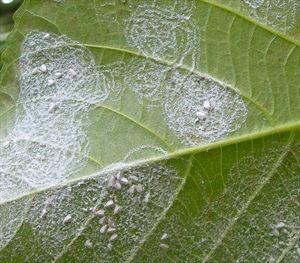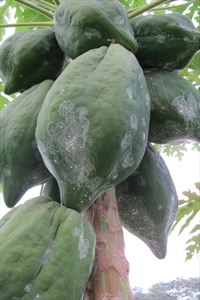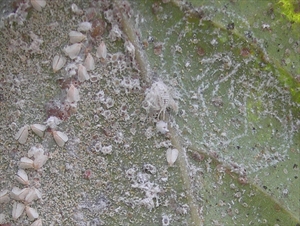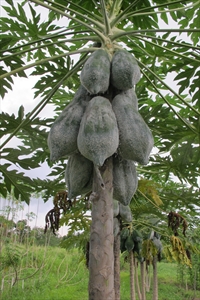Spiralling whitefly
Pacific Pests, Pathogens, Weeds & Pesticides - Online edition
Pacific Pests, Pathogens, Weeds & Pesticides
Spiralling whitefly (025)
Aleurodicus dispersus. A member of the Aleyrodidae.
Asia, Africa, North (Florida, Hawaii), South and Central America, the Caribbean, Europe (restricted), Oceania. It is recorded in Australia, American Samoa, Cook Islands, Fiji, French Polynesia, Guam, Kiribati, Marshall Islands, Nauru, New Caledonia, Northern Marianas Islands, Palau, Papua New Guinea, Samoa, Solomon Islands, Tokelau, Tonga, and Vanuatu.
Spiralling whitefly has a very wide host range, including banana, cassava, citrus, papaya, mango, custard apple, guava, taro, tomato, capsicum, eggplant and also many ornamental species, shade trees and weeds. The adult makes distinctive spiralling patterns when laying eggs on the under surface of leaves or on fruits; this gives the insect its name.
Damage is caused by the whitefly piercing the leaf and sucking the sap; this leads to early death when whitefly numbers are high. Damage is also caused by build-up of sooty mould (see Fact Sheet no. 51). Sooty moulds (fungi) grow on the honeydew produced by the whiteflies and their nymphs as they feed. The mould weakens the leaves, as they cannot get sufficient sunlight for normal growth.
The eggs are smooth, yellow to tan, oval, 0.3 mm long. They are laid in a spiral pattern within a trail of white wax (Photos 1-3). The eggs hatch after 7-10 days.
After hatching, crawlers (nymphs or larvae) move to the leaf veins to feed. As they mature, they develop waxy tufts. There are four nymph stages, with moults between each (Photo 3). At first, the nymphs are mobile, but later, after they moult, they become attached to the leaf and stay there. The last nymph stage feeds at first and then stops, undergoes internal rearrangement, and then moults to become an adult (Photo 4). The four nymph stages take 20-35 days depending on temperature.
The adults live for about 2 weeks. Males are 2.2 mm long; females, 1.7 mm. Adults are able to fly. The forewings have two characteristic dark spots. Egg laying begins a few days after emergence.
Populations decrease during cool, rainy days, and increase again when days are warm and dry. They may become especially high during droughts, when, presumably, the natural enemies decline (Photos 5&6).
Spread occurs with the short-distance movement of the crawler nymphs, and by the winged adults. Over long distances spread is on plants involved in the international horticultural trade.
Spiralling whitefly has a high reproduction and dispersal rate. It has posed a major threat to banana, tropical fruit tree, vegetable and ornamental industries. There are no published measurements of yield losses. However, damage due to direct feeding, cosmetic damage due to the white spirals, and indirect damage from excreted honeydew that encourages sooty moulds, are all likely to result in economic impacts.
In Costa Rica and Hawaii, high level of sooty mould of banana has caused premature leaf-drop and has been related to reduced yields.
Look for the small (2 mm long), white and moth-like adults on the undersides of the leaves. Look for whitefly eggs that are laid in the spirals produced by the females. These spirals are more noticeable initially, when numbers are low. They are also noticeable on the skin of fruits and the surface of vegetables.
Look for the whiteflies at dawn and dusk, calm times of the day. The whiteflies can be seen flying in large circular patterns around their host plants. They can be made to fly by shaking the plant, after which they quickly resettle.
NATURAL ENEMIES
A wasp parasite, Encarsia haitiensis, lays its eggs in immature whiteflies, killing them. Lacewings and ladybird beetle adults and larvae (Photo 7) attack all stages.
When Encarsia is not present, spiralling whiteflies multiply at a great rate, producing thousands of individuals on a single plant. However, when the parasitoid is present there is excellent control of the whitefly. It is a very efficient biocontrol agent, and is present throughout the Pacific islands. In some cases the parasitoid was introduced with the whitefly; in other cases it was introduced by government authorities.
CHEMICAL CONTROL
Attempts to control the pest using insecticides are not recommended. Spraying with insecticides has little long-term impact on the pest; it usually makes the problem worse by destroying the biocontrol agents, prolonging the infestation, and promoting insecticide resistance in whitefly populations. If insecticides are required, do the following:
- Use horticultural oil (made from petroleum), white oil (made from vegetable oils), or soap solution (see Fact Sheet no. 56). The spray will not kill all of the spiralling whiteflies, but it will suppress the population enough to allow predator and parasite numbers to build up and start to control them. Frequent applications (every 3-5 days) and good coverage is required.
- Several soap or oil sprays will be needed to bring the whiteflies under control. It is essential that the underside of leaves and terminal buds are sprayed thoroughly since these are the areas where the whiteflies congregate. It is best to spray between 4 and 6 pm to minimise the chance of leaves becoming sunburnt.
- White oil:
- 3 tablespoons (1/3 cup) cooking oil in 4 litres water.
- ½ teaspoon detergent soap.
- Shake well and use.
- Soap:
-
Use soap (pure soap, not detergent).
- 5 tablespoons of soap in 4 litres water, OR
- 2 tablespoons of dish washing liquid in 4 litres water.
-
- White oil:
- Commercial horticultural oil can also be used. Note, these sprays work by blocking the breathing holes of insects causing suffocation and death. They are less likely to kill natural enemies as they are quickly broken down in the environment, and also the development of resistance to them is less likely than is the case when using synthetic pesticides.
- Alternatively, use plant-derived products, chilli (see Fact Sheet no. 504), neem (see Fact Sheet no. 402) or derris (see Fact Sheet no. 56).
____________________
When using a pesticide (or biopesticide), always wear protective clothing and follow the instructions on the product label, such as dosage, timing of application, and pre-harvest interval. Recommendations will vary with the crop and system of cultivation. Expert advice on the most appropriate pesticide to use should always be sought from local agricultural authorities.
AUTHORS Helen Tsatsia & Grahame Jackson
Information from Chin D et al. Biology and pest management of spiralling whitefly. DPI&R. Northern Territory Government. (https://industry.nt.gov.au/__data/assets/pdf_file/0011/228089/ent1-biology-pest-management-spiraling-whitefly.pdf); and from Waterhouse DF, Norris KR (1989) Biological Control Pacific Prospects - Supplement 1. Australian Centre for International Agricultural Research, Canberra; and from Aleurodiscus (whitefly). Invasive Species Compendium. (https://www.cabi.org/isc/datasheet/4141).
Produced with support from the Australian Centre for International Agricultural Research under project PC/2010/090: Strengthening integrated crop management research in the Pacific Islands in support of sustainable intensification of high-value crop production, implemented by the University of Queensland and the Secretariat of the Pacific Community.










